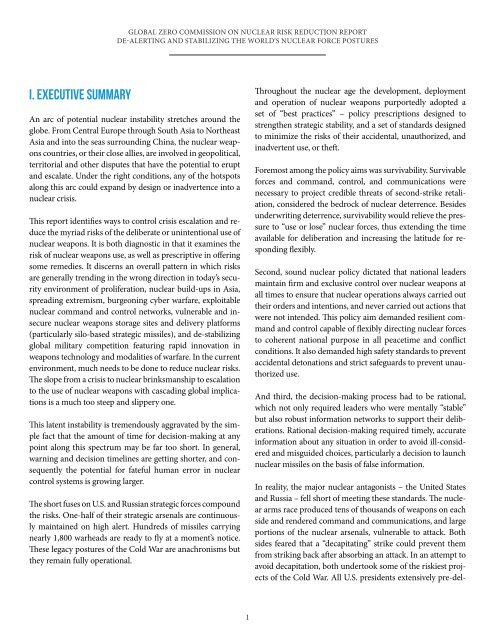global_zero_commission_on_nuclear_risk_reduction_report
global_zero_commission_on_nuclear_risk_reduction_report
global_zero_commission_on_nuclear_risk_reduction_report
Create successful ePaper yourself
Turn your PDF publications into a flip-book with our unique Google optimized e-Paper software.
GLOBAL ZERO COMMISSION ON NUCLEAR RISK REDUCTION REPORTDE-ALERTING AND STABILIZING THE WORLD’S NUCLEAR FORCE POSTURESI. EXECUTIVE SUMMARYAn arc of potential <strong>nuclear</strong> instability stretches around theglobe. From Central Europe through South Asia to NortheastAsia and into the seas surrounding China, the <strong>nuclear</strong> weap<strong>on</strong>scountries, or their close allies, are involved in geopolitical,territorial and other disputes that have the potential to eruptand escalate. Under the right c<strong>on</strong>diti<strong>on</strong>s, any of the hotspotsal<strong>on</strong>g this arc could expand by design or inadvertence into a<strong>nuclear</strong> crisis.This <strong>report</strong> identifies ways to c<strong>on</strong>trol crisis escalati<strong>on</strong> and reducethe myriad <strong>risk</strong>s of the deliberate or unintenti<strong>on</strong>al use of<strong>nuclear</strong> weap<strong>on</strong>s. It is both diagnostic in that it examines the<strong>risk</strong> of <strong>nuclear</strong> weap<strong>on</strong>s use, as well as prescriptive in offeringsome remedies. It discerns an overall pattern in which <strong>risk</strong>sare generally trending in the wr<strong>on</strong>g directi<strong>on</strong> in today’s securityenvir<strong>on</strong>ment of proliferati<strong>on</strong>, <strong>nuclear</strong> build-ups in Asia,spreading extremism, burge<strong>on</strong>ing cyber warfare, exploitable<strong>nuclear</strong> command and c<strong>on</strong>trol networks, vulnerable and insecure<strong>nuclear</strong> weap<strong>on</strong>s storage sites and delivery platforms(particularly silo-based strategic missiles), and de-stabilizing<str<strong>on</strong>g>global</str<strong>on</strong>g> military competiti<strong>on</strong> featuring rapid innovati<strong>on</strong> inweap<strong>on</strong>s technology and modalities of warfare. In the currentenvir<strong>on</strong>ment, much needs to be d<strong>on</strong>e to reduce <strong>nuclear</strong> <strong>risk</strong>s.The slope from a crisis to <strong>nuclear</strong> brinksmanship to escalati<strong>on</strong>to the use of <strong>nuclear</strong> weap<strong>on</strong>s with cascading <str<strong>on</strong>g>global</str<strong>on</strong>g> implicati<strong>on</strong>sis a much too steep and slippery <strong>on</strong>e.This latent instability is tremendously aggravated by the simplefact that the amount of time for decisi<strong>on</strong>-making at anypoint al<strong>on</strong>g this spectrum may be far too short. In general,warning and decisi<strong>on</strong> timelines are getting shorter, and c<strong>on</strong>sequentlythe potential for fateful human error in <strong>nuclear</strong>c<strong>on</strong>trol systems is growing larger.The short fuses <strong>on</strong> U.S. and Russian strategic forces compoundthe <strong>risk</strong>s. One-half of their strategic arsenals are c<strong>on</strong>tinuouslymaintained <strong>on</strong> high alert. Hundreds of missiles carryingnearly 1,800 warheads are ready to fly at a moment’s notice.These legacy postures of the Cold War are anachr<strong>on</strong>isms butthey remain fully operati<strong>on</strong>al.Throughout the <strong>nuclear</strong> age the development, deploymentand operati<strong>on</strong> of <strong>nuclear</strong> weap<strong>on</strong>s purportedly adopted aset of “best practices” – policy prescripti<strong>on</strong>s designed tostrengthen strategic stability, and a set of standards designedto minimize the <strong>risk</strong>s of their accidental, unauthorized, andinadvertent use, or theft.Foremost am<strong>on</strong>g the policy aims was survivability. Survivableforces and command, c<strong>on</strong>trol, and communicati<strong>on</strong>s werenecessary to project credible threats of sec<strong>on</strong>d-strike retaliati<strong>on</strong>,c<strong>on</strong>sidered the bedrock of <strong>nuclear</strong> deterrence. Besidesunderwriting deterrence, survivability would relieve the pressureto “use or lose” <strong>nuclear</strong> forces, thus extending the timeavailable for deliberati<strong>on</strong> and increasing the latitude for resp<strong>on</strong>dingflexibly.Sec<strong>on</strong>d, sound <strong>nuclear</strong> policy dictated that nati<strong>on</strong>al leadersmaintain firm and exclusive c<strong>on</strong>trol over <strong>nuclear</strong> weap<strong>on</strong>s atall times to ensure that <strong>nuclear</strong> operati<strong>on</strong>s always carried outtheir orders and intenti<strong>on</strong>s, and never carried out acti<strong>on</strong>s thatwere not intended. This policy aim demanded resilient commandand c<strong>on</strong>trol capable of flexibly directing <strong>nuclear</strong> forcesto coherent nati<strong>on</strong>al purpose in all peacetime and c<strong>on</strong>flictc<strong>on</strong>diti<strong>on</strong>s. It also demanded high safety standards to preventaccidental det<strong>on</strong>ati<strong>on</strong>s and strict safeguards to prevent unauthorizeduse.And third, the decisi<strong>on</strong>-making process had to be rati<strong>on</strong>al,which not <strong>on</strong>ly required leaders who were mentally “stable”but also robust informati<strong>on</strong> networks to support their deliberati<strong>on</strong>s.Rati<strong>on</strong>al decisi<strong>on</strong>-making required timely, accurateinformati<strong>on</strong> about any situati<strong>on</strong> in order to avoid ill-c<strong>on</strong>sideredand misguided choices, particularly a decisi<strong>on</strong> to launch<strong>nuclear</strong> missiles <strong>on</strong> the basis of false informati<strong>on</strong>.In reality, the major <strong>nuclear</strong> antag<strong>on</strong>ists – the United Statesand Russia – fell short of meeting these standards. The <strong>nuclear</strong>arms race produced tens of thousands of weap<strong>on</strong>s <strong>on</strong> eachside and rendered command and communicati<strong>on</strong>s, and largeporti<strong>on</strong>s of the <strong>nuclear</strong> arsenals, vulnerable to attack. Bothsides feared that a “decapitating” strike could prevent themfrom striking back after absorbing an attack. In an attempt toavoid decapitati<strong>on</strong>, both undertook some of the <strong>risk</strong>iest projectsof the Cold War. All U.S. presidents extensively pre-del-1


